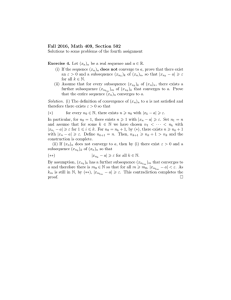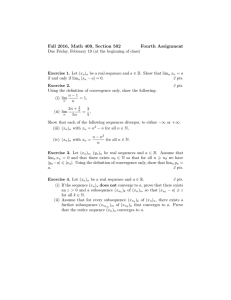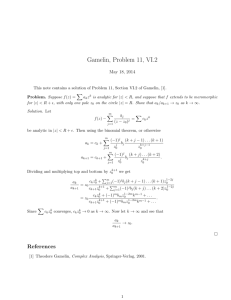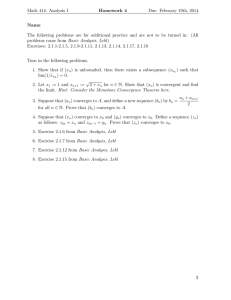Document 10909288
advertisement
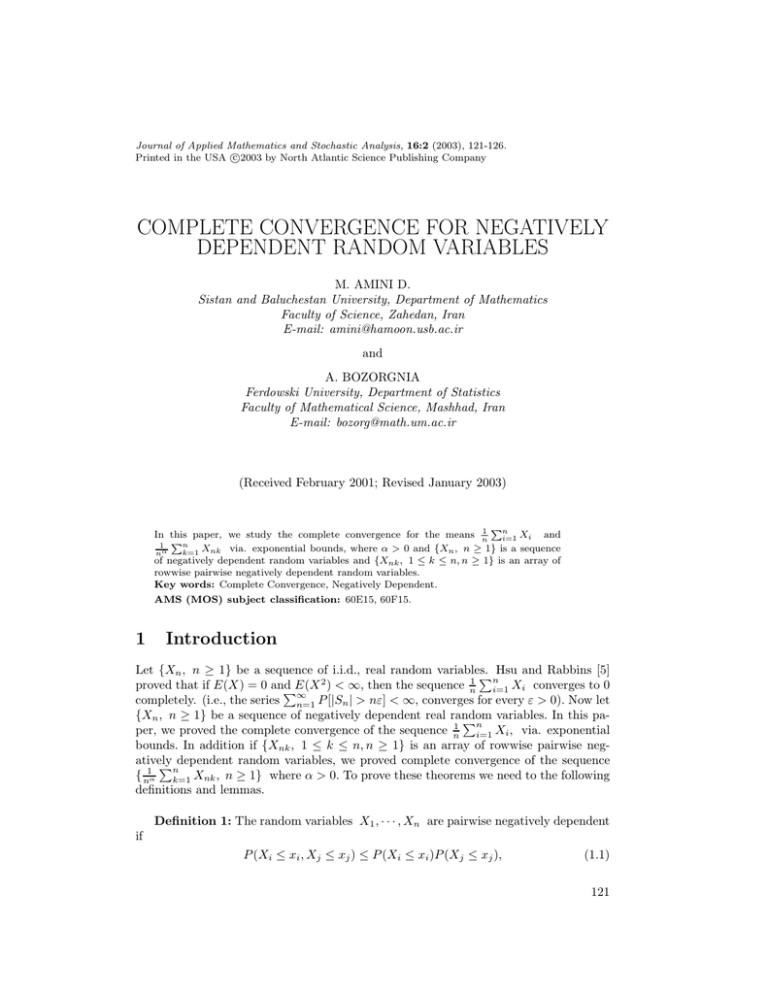
Journal of Applied Mathematics and Stochastic Analysis, 16:2 (2003), 121-126.
c
Printed in the USA 2003
by North Atlantic Science Publishing Company
COMPLETE CONVERGENCE FOR NEGATIVELY
DEPENDENT RANDOM VARIABLES
M. AMINI D.
Sistan and Baluchestan University, Department of Mathematics
Faculty of Science, Zahedan, Iran
E-mail: amini@hamoon.usb.ac.ir
and
A. BOZORGNIA
Ferdowski University, Department of Statistics
Faculty of Mathematical Science, Mashhad, Iran
E-mail: bozorg@math.um.ac.ir
(Received February 2001; Revised January 2003)
P
P
n
1
In this paper, we study the complete convergence for the means n
and
i=1 Xi
n
1
k=1 Xnk via. exponential bounds, where α > 0 and {Xn , n ≥ 1} is a sequence
nα
of negatively dependent random variables and {Xnk , 1 ≤ k ≤ n, n ≥ 1} is an array of
rowwise pairwise negatively dependent random variables.
Key words: Complete Convergence, Negatively Dependent.
AMS (MOS) subject classification: 60E15, 60F15.
1
Introduction
Let {Xn , n ≥ 1} be a sequence of i.i.d., real random variables.
PnHsu and Rabbins [5]
1
2
)
<
∞,
then
the
sequence
proved that if E(X) = 0 and
E(X
i=1 Xi converges to 0
n
P
P
[|S
|
>
nε]
<
∞,
converges
for
every ε > 0). Now let
completely. (i.e., the series ∞
n
n=1
{Xn , n ≥ 1} be a sequence of negatively dependent real random
Pn variables. In this paper, we proved the complete convergence of the sequence n1 i=1 Xi , via. exponential
bounds. In addition if {Xnk , 1 ≤ k ≤ n, n ≥ 1} is an array of rowwise pairwise negatively
Pndependent random variables, we proved complete convergence of the sequence
{ n1α k=1 Xnk , n ≥ 1} where α > 0. To prove these theorems we need to the following
definitions and lemmas.
Definition 1: The random variables X1 , · · · , Xn are pairwise negatively dependent
if
P (Xi ≤ xi , Xj ≤ xj ) ≤ P (Xi ≤ xi )P (Xj ≤ xj ),
(1.1)
121
122
M. AMINI and A. BOZORGNIA
for all xi , xj ∈IR, i 6= j. It can be shown that (1.1) is equivalent to
P (Xi > xi , Xj > xj ) ≤ P (Xi > xi )P (Xj > xj ),
(1.2)
for all xj , xi ∈IR , i 6= j.
Definition 2: The random variables X1 , · · · , Xn are said to be negatively dependent (ND) if we have
n
Y
P (∩nj=1 (Xj ≤ xj )) ≤
P (Xj ≤ xj ),
(1.3)
P (Xj > xj ),
(1.4)
j=1
and
n
Y
P (∩nj=1 (Xj > xj )) ≤
j=1
for all x1 , · · · , xn ∈IR. An infinite sequence {Xn , n ≥ 1} is said to be ND if every
finite subset {X1 , · · · , Xn } is ND.
Conditions (1.3) and (1.4) are equivalent for n = 2. However Ebrahimi and Ghosh
[4] show that these definitions do not agree for n ≥ 3.
Definition 3: The sequence {Xn , n ≥ 1} of random variables converges to zero
completely (denoted limn→∞ Xn = 0 completely), if for every ε > 0
∞
X
P [|Xn | > ε] < ∞.
(1.5)
n=1
Lemma 1: (Petrov [8]) Let X be a random variable with E(X) = 0, E(X 2 ) < ∞,
and suppose there exists a positive constant H such that for all m ≥ 2
|E(X m )| ≤
then for every |t| ≤
1
m!σ 2 H m−2 ,
2
1
2H
EetX ≤ et
2
σ2
(1.6)
.
Lemma 2: (Serfeling [9]) Let X be a r.v. with E(X) = µ. If P [a ≤ X ≤ b] =
1. Then for every real number h > 0,
Eeh(X−µ) ≤ e
h2 (b−a)2
8
and
Eeh|X−µ| ≤ 2e
h2 (b−a)2
8
,
.
The next three lemmas will be needed in the proofs of the strong law of large numbers
in the next section [3].
Lemma 3: Let X1 , · · · , Xn be ND random variables and f1 , · · · , fn be a sequence
of Borel functions which all are monotone increasing (or all are monotone decreasing),
then f1 (X1 ), · · · , fn (Xn ) are ND random variables.
Lemma 4: Let X1 , · · · , Xn be pairwise ND random variables, then
E(Xi Xj ) ≤ E(Xi )E(Xj ),
∀
i 6= j.
Complete Convergence
123
Lemma 5: Let X1 , · · · , Xn be ND nonnegative random variables, then
E[
n
Y
Xj ] ≤
j=1
2
n
Y
E[Xj ].
j=1
Exponential Bounds and Complete Convergence
In this section, we obtained some exponential bounds for probability P [|Sn | > x] for
every x > 0 using P
Lemmas 1 and 2, and then we proved the complete convergence
n
of the sequence { n1 i=1 Xi }. We shall consider a sequence of ND random variables
{Xn , n ≥ 1}, with zero means and finite variances . We put
Sn =
n
X
Xk ,
Bn =
k=1
n
X
σk2 .
k=1
Theorem 1: Let {Xn , n ≥ 1} be a sequence of ND r.v.’s and suppose there exists
a positive constant H such that for all m ≥ 2 and 1 ≤ k ≤ n,
|E(Xkm )| ≤
if
P∞
n=1
1
m!σk2 H m−2 ,
2
(2.7)
2 2
exp[− n4Bεn ] < ∞, for every ε > 0, then
n
1X
Xk −→ 0,
n
completely.
k=1
Proof: By Lemmas 1, 3, 5 and Markov’s inequality for every |t| ≤
1
2H
we have
P [|Sn | ≥ x] ≤ P [Sn ≥ x] + P [−Sn ≥ x] ≤ e−tx EetSn + e−tx Ee−tSn
≤ e−tx (
n
Y
EetXk +
k=1
n
Y
Ee−tXk ) ≤ 2 exp[−tx + t2 Bn ].
k=1
Hence
P [|Sn | ≥ x] ≤ 2 exp[−tx + t2 Bn ].
(2.8)
With h(t) = t2 Bn − tx and 0 ≤ x ≤ BHn , the equation h0 (t) = 0 has the unique
solution t = 2Bx n which minimize h(t). Hence
P [|Sn | ≥ x] ≤ 2 exp[−
x2
]
4Bn
if 0 ≤ x ≤
Bn
.
H
Let a = BHn? , where n? is the first subscript so that Bn > 0. Then for every 0 < ε ≤ a,
and by the assumption
∞
X
n=1
P[
∞
X
|Sn |
n2 ε2
≥ ε] ≤
2 exp[−
] < ∞,
n
4Bn
n=1
124
M. AMINI and A. BOZORGNIA
and for each ε0 > a ≥ ε > 0, we have
[
∞
X
P[
n=1
∞
X
|Sn |
|Sn |
≥ ε0 ] ≤
≥ ε] < ∞.
P[
n
n
n=1
These complete the proof.
P
n 2 ε2
Remark 1: In particular if Bn = O(nα ), 0 < α < 2, then series ∞
n=1 exp[− 4Bn ]
converges.
Remark 2: If the random variables X1 , X2 , · · · , Xn are ND r.v.’s with zero means
and uniformly bounded, that is if there exists a positive constant c such that
P [|Xk | ≤ c] = 1,
k≥1
then for all integers m ≥ 2 we have
|E(Xkm )| ≤ cm−2 σk2 .
Thus Condition (1.6) in Lemma 1 is satisfied with H = c. Hence if
∞, for every ε > 0, then
P∞
2 2
n=1
exp[− n4Bεn ] <
n
1X
Xk −→ 0,
n
completely.
k=1
Theorem 2: Let {Xn , n ≥ 1} be a sequence of ND random variables and
P∞
|Xk |
2nε2
, 1 ≤ k ≤ n}. If
cn = max{ess sup √
n=1 exp[− c2 Bn ] < ∞, then for each ε > 0,
B
n
n
1
n
n
X
Xk −→ 0,
completely.
k=1
Proof: By Lemmas 2, 3, 5 and Markov’s inequality for every t > 0, we have
− √tε
B
P [|Sn | > ε] ≤ P [Sn > ε] + P [−Sn > ε] ≤ e
− √tε
B
≤e
n
{
n
Y
(Ee
tX
√ k
Bn
k=1
Thus, for t =
ε
√
nc2n Bn
+ Ee
−tXk
√
Bn
n
Ee
tS
√ n
Bn
− √tε
B
+e
n
Ee
−tSn
√
Bn
tε
nt2 c2n
].
)} ≤ 2 exp[− √
+
2
Bn
we have
P [|Sn | > ε] ≤ 2 exp[−
ε2
],
2nc2n Bn
and by the assumption we have
∞
X
n=1
P[
∞
X
|Sn |
nε2
> ε] ≤ 2
exp[− 2
]<∞
n
2cn Bn
n=1
which completes the proof.
P
nε2
Remark 3: In particular if c2n Bn = O(nα ), 0 < α < 1, then series ∞
n=1 exp[− 2cn Bn ]
converges.
Complete Convergence
3
125
Strong Limit Theorem for arrays
Let {Xnk , 1 ≤ k ≤ n, n ≥ 1} be an array of rowwise pairwise ND random variables
with
2
2
= E[Xnk
], 1 ≤ k ≤ n, n ≥ 1.
E[Xnk ] = 0, σnk
P
n
We consider the means ξn = n1α k=1 Xnk , n ≥ 1 where α is a fixed positive real
number. Since Xnk , 1 ≤ k ≤ n are pairwise ND random variables, by Lemma 4 we can
write
n
1 X 2
σnk ,
(3.9)
E[ξn2 ] ≤ 2α
n
k=1
because
E[ξn2 ] = E[
n
n
n
1 X
1 XX
2
X
]
=
E[Xnk Xnj ]
nk
nα
n2α
j=1
k=1
=
1
[
n2α
n
X
2
E[Xnk
]+
k=1
XX
k=1
E[Xnk Xnj ]] ≤
k6=j
n
1 X 2
σnk .
n2α
k=1
Theorem 3: Let {Xnk , 1 ≤ k ≤ n, n ≥ 1} be an array of rowwise pairwise ND
random variables with E[Xnk ] = 0. If for some α > 0
∞
n
X
1 X 2
σnk < ∞,
n2α
n=1
k=1
then
n
1 X
Xnk −→ 0
nα
completely.
k=1
Proof: By Chebyshev’s inequality and (3.9), we have
n
1
1 X 2
2
σnk .
P [|ξn | > ε] ≤ 2 E[ξn ] ≤ 2 2α
ε
ε n
k=1
Since for some α > 0
∞
X
P [|ξn | > ε] ≤
n=1
∞
X
n
1 X 2
σnk < ∞,
ε2 n2α
n=1
k=1
by Definition 3
n
1 X
Xnk −→ 0
nα
completely.
k=1
Corollary 1: Under assumptions of Theorem 3, let σnk ≤ σkk , k ≥ 1, n ≥
2
P∞ σkk
1
(k + 1). If
k=1 k2α−1 < ∞ for some α > 2 then
n
1 X
Xnk −→ 0
nα
k=1
completely.
126
M. AMINI and A. BOZORGNIA
Proof: We have
∞
X
E[ξn2 ]
n=1
∞
∞
n
n
X
X
1 X 2
1 X 2
≤
σnk ≤
σkk
n2α
n2α
n=1
n=1
k=1
=
∞
X
2
σkk
k=1
then
∞
X
∞
X
n=k
k=1
1
= O(1)
n2α
P [|ξn | > ε] ≤ O(1)
n=1
∞
X
k=1
2
σkk
k 2α−1
,
∞
2
X
σkk
< ∞,
k 2α−1
k=1
which completes the proof.
2
P
σkk
Remark 4: The weaker condition ∞
k=1 k2α < ∞, for every α > 0, implies only the
complete convergence of subsequence {ξ2p , p = 0, 1, 2, ....}, since
∞
X
p
E[ξ22p ] ≤
p=0
=
∞
X
k=1
2
σkk
∞
2
X
1 X 2
σkk
22αp
p=0
k=1
X
p:2p ≥k
1
22αp
= O(1)
∞
X
σ2
kk
k=1
k 2α
.
Acknowledgments
The authors would like to thank the referee for his careful reading of the manuscript
and for many valuable suggestions which improved the presentation of the paper.
References
[1] Amini, D.M. and Bozorgnia,A., Negatively dependent bounded random variables, probability inequalities and the strong law of large numbers, J. of Appl. Math. and Stoch. Anal.
13:3 (2000), 261–267.
[2] Amini, D.M., Azarnoosh,H.A., and Bozorgnia,A., The almost sure convergence of
weighted sums of ND uniformly bounded random variables, J. of Sci. Islamic Republic
of Iran 10:2 (1999), 112–116.
[3] Bozorgnia, A., Patterson, R.F, and Taylor, R.L., Limit theorems for dependent random
variables, In: World Congress Nonl. Anal. ’92 (ed. by V. Lakshmikantham), Walter de
Gruyter Publ., Berlin (1996), 1639–1650.
[4] Ebrahimi, N. and Ghosh, M., Multivariate negative dependence, Commun. Stat. Theory. Math. 4 (1981), 307–337.
[5] Hsu, P.L. and Robbins, H., Complete convergence and the law of large numbers,
Proc.Nat.Acad. Sci. 33 (1947), 25–31.
[6] Laha, R.G and Rohatgi, V.K., Probability Theory, John Wiley & Sons, New York 1979.
[7] Loève, M., Probability Theory, Van Nostrand Reinhold Company 1963.
[8] Petrov, V.V., Limit Theorems of Probability Theory, Oxford, New York 1995.
[9] Serfling, R.J., Approximation Theorems of Mathematical Statistics, John Wiley & Sons,
New York 1980.
